Keyboard Wonderland – ENGLISH Version – Part I
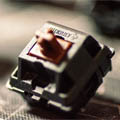
2.2. MX, Outemu, Gateron, Kailh, pasta, spaghetti
MX is the brand Cherry uses for some of their switches and we can also consider it a standard. When the Cherry patent expired the clones started to appear however unlike in the Alps case the original never left the market. Or at least not in the way we would expect.
The contacts of a switch are encased in plastic housings. Plastic is injected into moulds to give these housings their shape. Unfortunately these moulds have a limited life span and need to eventually be replaced. However when the time comes there is always somebody coming up with ideas on how to improve the product being guided by a mantra similar to “if it isn’t broken, fix it until it is”. As a result you will encounter on the internet stuff like “retooled Cherry MX Blacks” – this means that these switches have been produced with the “new” moulds. I am using the quotation marks because this has happened years ago so these retooled switches have been the norm for some time. You will also find expressions like “vintage Cherry MX Blacks” – which are old Cherry MX Black switches from keyboards assembled before the moulds were replaced and which are highly sought after due to their perceived superior smoothness.
Now if we think about it – is the smoothness of the old switches not encountered on the new switches an issue with the moulds or is it because these vintage switches have been extracted from old keyboards which were used for decades by secretaries and are actually only very well broken in switches? We will probably never know (yes we do, we shall circle back to breaking in switches at the opportune moment).
What we can say for sure is that in time Cherry MX Clones made by Gateron and Kailh started to surpass the originals in quality. Having a preference for a switch however is a personal preference and there is no switch that is “better” than another in 2022 unless you look at it from the personal preference angle.
I want to reiterate on the fact that there is no perfect switch. Is there criteria that we may use in assessing a switch? Yes. Is that criteria subjective? Definitely.
Let us have a look at the most frequent statements and why they are wrong:
- a light switch is better than a heavy switch; it is wrong because there are people who prefer 80g springs and others prefer 45g springs. There are 62.5g switches and 55g switches and there are a lot of other spring options in between, either as an option to the switch itself or as aftermarket spring options. It also means that nobody is wrong when stating that a certain switch is perfect. It is for them. It may not be for others; just as somebody prefers a foam pillow to a goose feather pillow and vice-versa.
- a silent switch is better than a noisy switch; again, wrong; there are people who prefer Kailh Box Navy or Box Jade switches and there are people who prefer Topre and Zilents v2. And a lot of people in between. And it is wonderful because a lot of switches have specific sound signatures and when combined with the myriad cases available can yield a lot of unique acoustics which each user can enjoy;
- a scratchy switch is worse than a smooth switch; this is debatable. I personally love smooth switches and I use lube to further emphasise this quality; however there are a LOT of people who don’t mind at all a scratchier switch (e.g. most silent switches). It is all preference-driven.
I believe that a switch is more than the sum of its parts and it always depends on what you are looking for personally. At the moment there are a lot of options available – and you can read reviews about a lot of he MX offer (and not only) here.
Unfortunately MX clones have not penetrated the prebuilt market in a significant way. Razer worked with Kailh who developed their switches which subsequently were branded Razer. Gateron are rarely found on prebuilt keyboards and generally options for a prebuilt are more of a colour preference rather than a specific manufacturer which is almost exclusively Cherry with sprinklings of Gateron, Outemu, and Kailh. And I feel that is indeed a pity since my personal preferences are leaning towards Gateron and Kailh who made incredible progress with some switches like the Gateron Yellow, the Gateron Black Ink, or the Kailh Box.
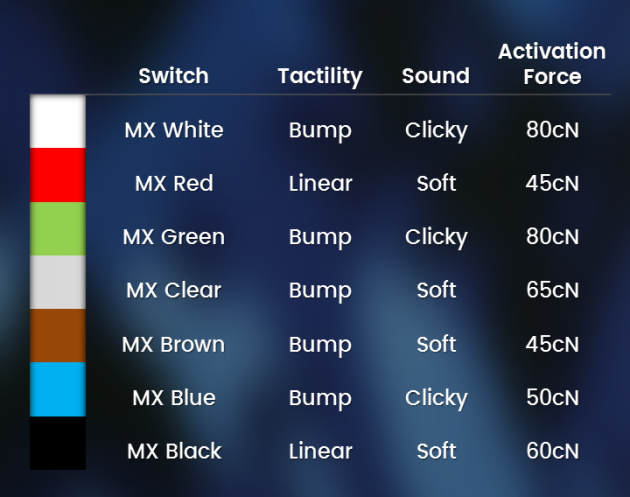
A table showing some actuation forces for some colours – these are usually manufacturer specific – as an example Halo Clears have a white stem and are liniar switches.
The colour standard – blue, brown, black, red. The four ubiquitous colours when choosing a keyboard switch. Let us delve into this a bit. Simultaneously let us agree regarding switch classification by feedback:
- tactiles;
- linears.
That really is it. Nothing more. Please don’t say clicky.
Mechanical switches are the direct descendants of the typewriters of old. So it is only natural to have a characteristic reminding us of them. Tactile switches have a noticeable bump when typing on them with the sole purpose of offering feedback regarding actuation and remind us about the typewriters of old. The amount of tactility however differs by switch construction, materials used, and the spring involved. There are switches which are lovingly and jokingly called “scratchy linears” (Cherry MX Brown) due to their tactile bump which is barely noticeable and there are switches with big, bold, round bumps taking front and centre row to the show like Holy Pandas or Zilents v2. Due to this bump in theory you could type on these without ever bottoming out.
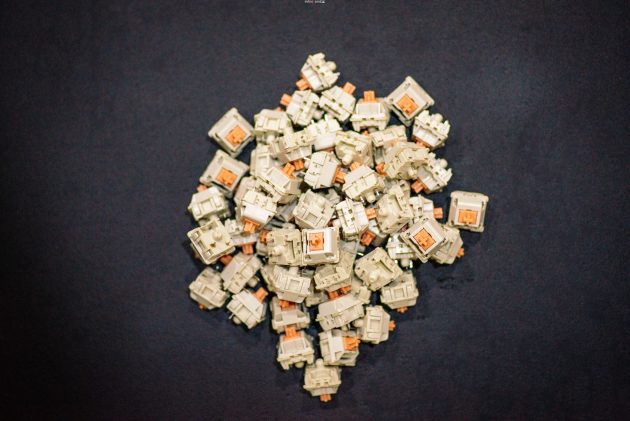
Holy Panda switches lubed with Tribosys 3203. Unlike most MX switches, these are “Frankenswitches”, assembled from the stem of a Halo switch (Clear = white, True = salmon) and the housing of an Invyr Panda switch. This is partially why these switches do not benefit from filming them.
Linear switches have the same movement from top to bottom out without any tactile bump. There are regular linears and there are progressive spring linears which bring something new to an otherwise pretty consistent switch experience. An example here are the Thic Thock Marshmallow switches which indeed feel like typing on marshmallows if you insist on bottoming out due to their progressive spring.

Thic Thock Marshmallows lubed with Krytox 205G00 and filmed with TX yellow switch films waiting to be assembled on top of a carbon fibre plate.
Now going back to the colours – black and red are linears; brown and blue are tactile; the blue colour comes with a “click” attached to the switch sound which comes from a click jacket (Cherry MX Blues) or a click bar (Kailh Box Navies/Jades). The sound difference between the two resides in how they generate the click – for the click jacket it is only on press/actuation whereas for the click bar the click is both on pressing and releasing the switch. This usually results in the colleague using Box Navies/Jades being evicted from the building long before his colleague using Cherry MX Blues with the time differential accounting for the recovery of the ear drums in the company as a whole.
Nowadays we have an influx of a lot of new colours – there are yellow switches, orange switches, light blue switches, teal switches, violet switches, purple switches, pink switches, and so on. Each of these has something special, something to praise, and something to criticise about. Just remember to state why you personally like/dislike it and you are good to go. Ladies and gentlemen, we are living marvellous times for a wide array of preferences in this field.

Comentarii
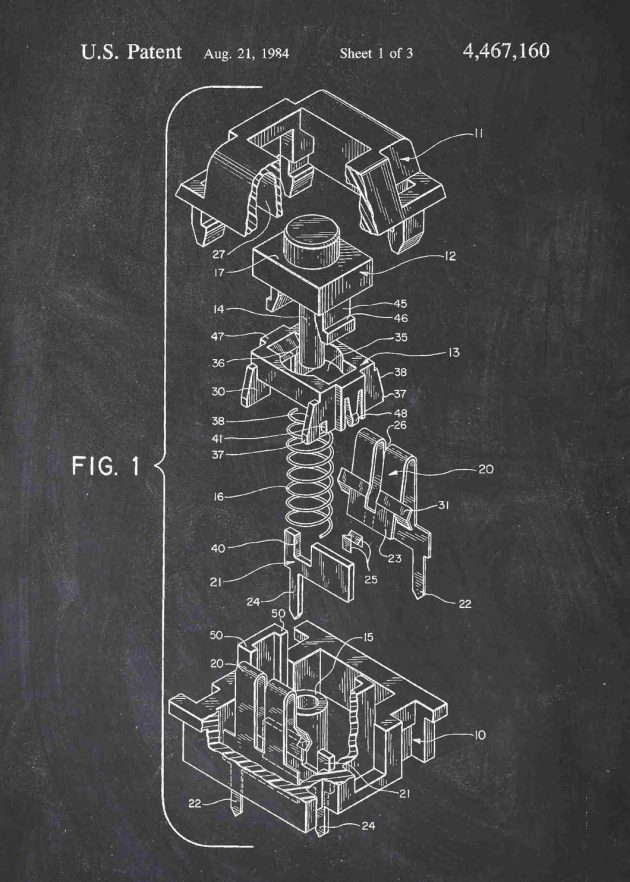
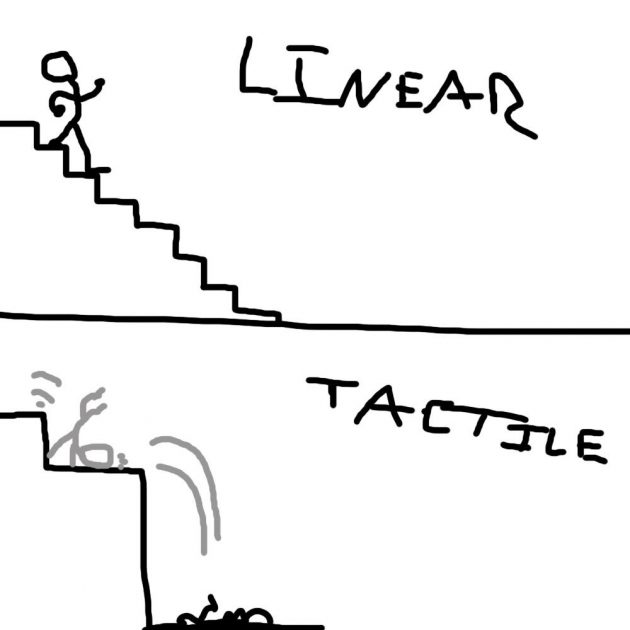









Kinesis copied Maltron.
Ian, I’m sorry, but if you point far enough backwards in time a germ gets blamed for splitting in two. Maltron had the ideas but the execution has been thoroughly terrible throughout time and they never caught on. At the same time I didn’t want to touch upon too much history because the article is complex enough as it is.
That being said, Kinesis is one of the first actually ergonomic keyboards that is actually good and was available and came up in searches online back around 2005ish, so I went with it as the contemporary origins. Maltron will always be remembered for this abomination which sold for $400 – https://youtu.be/fkGpFeUQ49Y
Pingback: PFU/Fujitsu Happy Hacking Keyboard Professional Hybrid Type-S ENGLISH version – next lab501